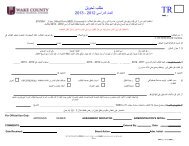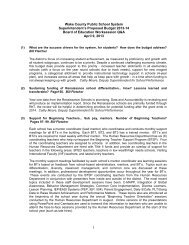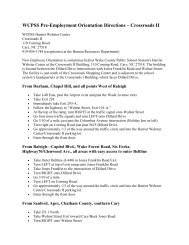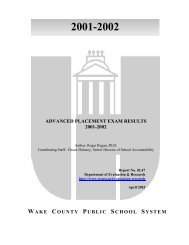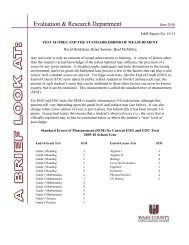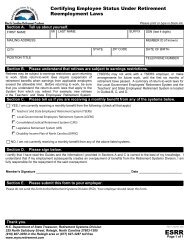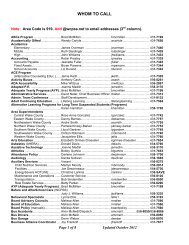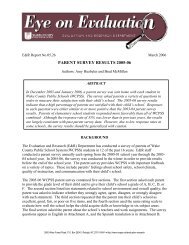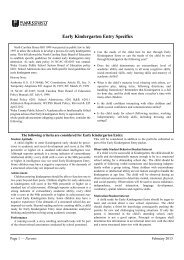2007-08 Adopted Plan - Wake County Public School System
2007-08 Adopted Plan - Wake County Public School System
2007-08 Adopted Plan - Wake County Public School System
Create successful ePaper yourself
Turn your PDF publications into a flip-book with our unique Google optimized e-Paper software.
The Reporting Entity and Its ServicesThe <strong>School</strong> <strong>System</strong>The <strong>Wake</strong> <strong>County</strong> <strong>Public</strong> <strong>School</strong> <strong>System</strong> (WCPSS) is one comprehensiveschool district serving the entire county; including Raleigh, Cary, Apex,Wendell, Fuquay-Varina, Garner, Knightdale, Rolesville, <strong>Wake</strong> Forest,Holly Springs, Morrisville, and Zebulon. The system was created througha merger of the former <strong>Wake</strong> <strong>County</strong> and Raleigh City <strong>Public</strong> <strong>School</strong>systems in July 1976. The school system is the 23rd largest system inthe nation and the second largest in North Carolina. For 2006-07 it isserving over 128,072 students from kindergarten through 12th grade in93 elementary schools, 28 middle schools, 22 high schools, and fourspecial/optional schools. The system and its school board are committedto providing the highest possible quality of education to <strong>Wake</strong> <strong>County</strong>students, while maintaining fi scal responsibility and accountability.WCPSS is a large, complex system that requires effective leadershipat both the central and school levels to drive continuous improvements.Del Burns, superintendent, is the chief executive offi cer of WCPSS. Heand his senior leadership team set system direction, implement policy,and manage systemwide operations. In addition to the superintendentand his leadership team, principals, assistant principals, and centralleveladministrative staff comprise the districtwide administrative team.<strong>School</strong> leadership teams, of which principals are members, overseeschool improvement planning and other site-based managementresponsibilities.One of the superintendent’s responsibilities is to serve the board ofeducation. The Board consists of nine members, elected in districts bythe public, who serve four-year terms. The board of education meets atleast two times per month to consider policy issues and review systemperformance. Senior leadership is aligned to support the board ofeducation’s decision-making structure. The board has budget reviewauthority, but it is not a taxing body and must submit its annual budgetrequests to the <strong>Wake</strong> <strong>County</strong> Board of Commissioners, which controlsallocation of funds to the schools. In North Carolina the basic publiceducation program is funded by the state and is augmented with localfunds.Opportunities for public comment are provided through a public hearingat the beginning of each regular board meeting for items on the agendaand at the end of each regular board meeting for items not on the agenda.Each participant may address the board for three minutes.Principals are legally responsible for the operation of the schools inthe district. Principals work collaboratively with leadership teams attheir schools to develop, implement, and monitor school improvementplans (SIPs). All school staffs are involved in the school improvementprocess.The school system has over 16,703 full-time and part-time employeesand is the third largest employer in the Raleigh-Durham area. Thesystem has 8,732 regular classroom teachers, not including mediaspecialists, counselors, psychologists, etc. Most students are assignedto and attend their “base school”—the school assigned based on theparent’s or guardian’s home address. In some instances, the baseschool may be a magnet or year-round school since these schools havebase populations in addition to accepting applications. Transportationis provided for students living at least 1½ miles from the base school oroutside a safe walk-zone. For the magnet program, the same guidelinesapply if the child is accepted into the program.A total of 82 of the system’s 147 schools are magnet schools or are yearroundschools. Thirty-six offer a magnet program and 46 will operateon a year-round calendar. Magnet programs offer enhancementsto the North Carolina Standard Course of Study based on a themeor approach to teaching and learning. Year-round schools offer thestandard curriculum but operate on a multi-track calendar that enablesthe school to accommodate 25-33 percent more students than a schooloperating on a traditional calendar. All students registered in the <strong>Wake</strong><strong>County</strong> <strong>Public</strong> <strong>School</strong> <strong>System</strong> are eligible to apply to magnet school ora calendar option school. The magnet network features the followinginnovative programs: Gifted and Talented (GT), Gifted and Talented withAG Basics, University Connections, Leadership, Center for Leadershipand Technology, Creative Arts and Science, Community Model, ActiveLearning and Technology, International Baccalaureate, Montessori,Museums, Early College, International Studies, and GT/IB Center forHumanities, Sciences and the Arts. Magnet programs were establishedin 1982 as “<strong>School</strong>s of Choice” to attract families to downtown schools tofi ll under-utilized facilities and to promote diverse student populations.The program has proven to be highly successful and contributes to <strong>Wake</strong><strong>County</strong>’s stature as a leader in education.65 FY <strong>2007</strong>-<strong>08</strong> <strong>Plan</strong> for Student Success



